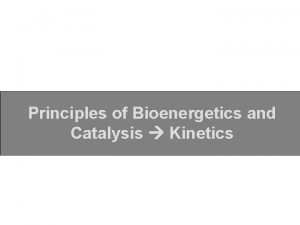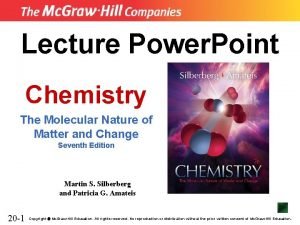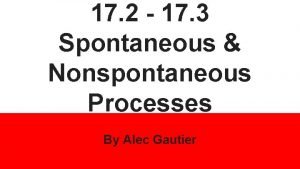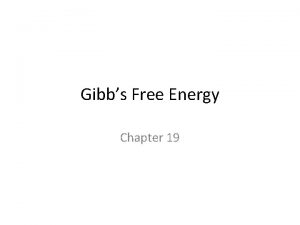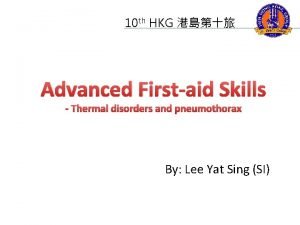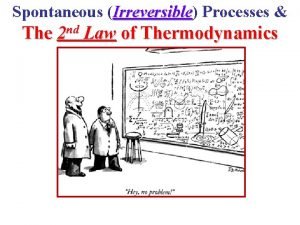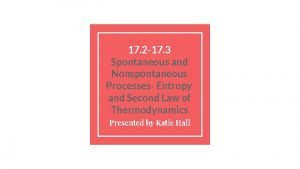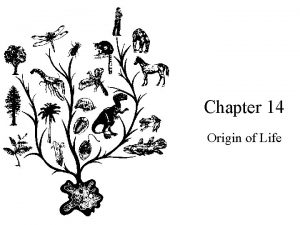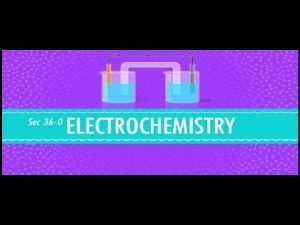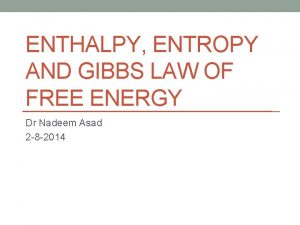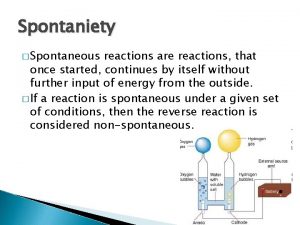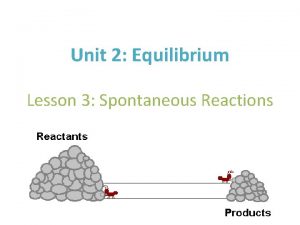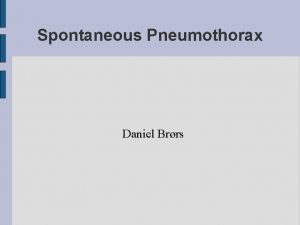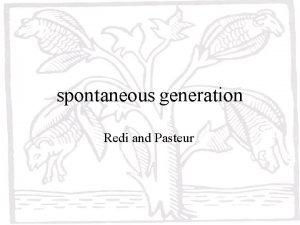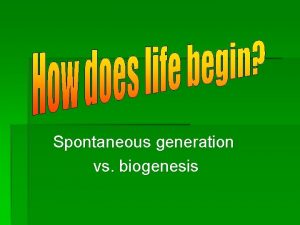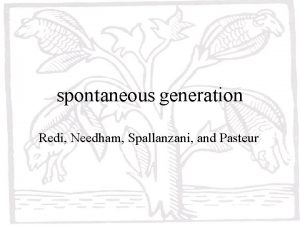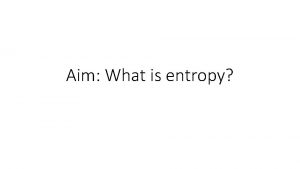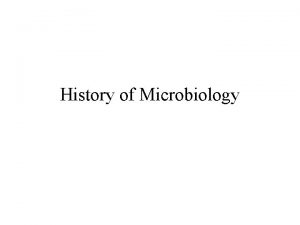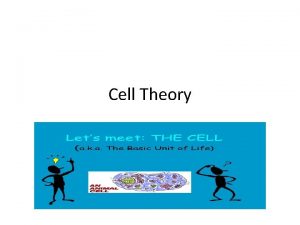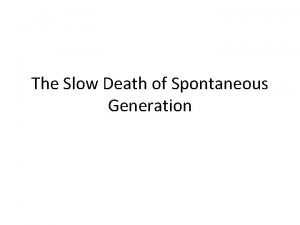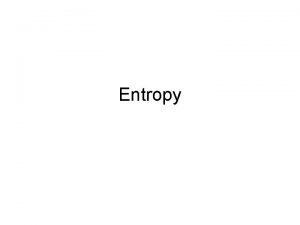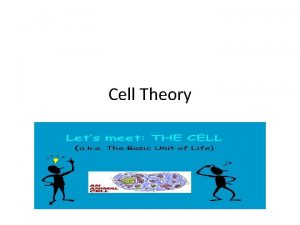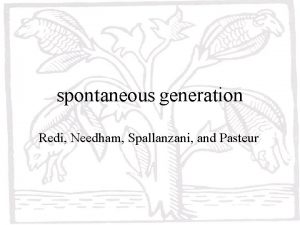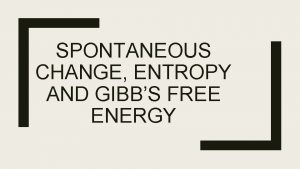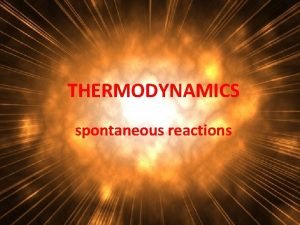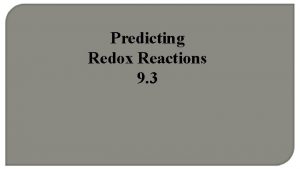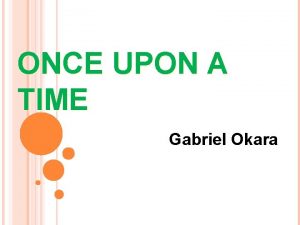Spontaniety Spontaneous reactions are reactions that once started





























- Slides: 29

Spontaniety � Spontaneous reactions are reactions, that once started, continues by itself without further input of energy from the outside. � If a reaction is spontaneous under a given set of conditions, then the reverse reaction is considered non-spontaneous.

Identifying Spontaneity • Identify whether the reactions below are spontaneous or not: – H 2 O (s) H 2 O (l) – 2 H 2 (g) + O 2 (g) 2 H 2 O (l) *requires a spark to begin – 2 H 2 O (l) 2 H 2 (g) + O 2 (g) *requires consistent electric current

Enthaply and Spontaneity: • Almost all exothermic reactions are considered to be spontaneous (at 25 *C and 1 atm). – ΔH for a spontaneous reactions tends to be negative. • • • However, some endothermic reactions at specific temperatures may be considered spontaneous, for example the melting of ice at 1 atm above 0 *C: H 2 O (s) H 2 O (l) ΔH = 6. 0 k. J Endothermic reactions that are non-spontaneous at room temperature often become spontaneous when the temperature is raised. The Randomness Factor: In general, nature tends to move spontaneously from more ordered to more random states (order to disorder).

Entropy � The randomness factor discussed is treated quantitatively as entropy (S). Basically the greater the disorder (more random the distribution of molecules) the greater the entropy. � 2 nd Law of Thermodynamics: In any spontaneous process there is always an increase in the entropy of the universe. � Entropy, like enthalpy is a state property so that ΔS = Sfinal - Sinitial ◦ unit for S = J/mol K

Factors that influence entropy that a system has in a particular state: • • A liquid has higher entropy than the solid from which it is formed. A gas has a higher entropy than the liquid from which it is formed. Increasing the temperature of a substance increases its entropy. A completely ordered pure crystalline solid has an entropy of 0 K (3 rd law of thermodynamics).

Standard molar entropies of elements, compounds, and aqueous ions: • • • Elements have nonzero standard entropies. Standard molar entropies of pure substances are always positive quantities. Aqueous ions may have negative entropy values. As a group, gases tend to have higher entropies than liquids. An increase in the number of moles of a gas also leads to a higher entropy and vice versa. As a molecule becomes more complex, the higher the entropy (more ways for the atoms to move about with respect to one another).

Example 1 � Predict whether ΔS is positive or negative for each of the following processes: ◦ Taking dry ice from a freezer where its temperature is -80°C and allowing it to warm to room temperature ◦ Dissolving bromine in hexane ◦ Condensing gaseous bromine to liquid bromine

Example 2 Which of the following reactions results in the largest increase in entropy? (A) CO 2(s) CO 2(g) (B) H 2(g) + Cl 2(g) 2 HCl(g) (C) KNO 3(s) KNO 3(l) (D) C(diamond) C(graphite)

Calculating Entropy � To calculate the standard entropy change, ΔS, use the following relation: ΔS = ∑ ΔS products - ∑ ΔS reactants � The 2 nd Law of Thermodynamics: In a spontaneous process, there is a net increase in entropy, taking into account both the system and surroundings, ΔS > 0

Example 3 � Calculate for the entropy change at 25ºC in J/K 2 SO 2(g) + O 2(g) 2 SO 3(g) given the following entropy data: ◦ SO 2(g): 248. 1 J/mol-K ◦ O 2(g): 205. 3 J/mol-K ◦ SO 3(g): 256. 6 J/mol-K � [2(256. 6)] - [2(248. 1) + 1(205. 3)] = -188. 3 J/K

Example 4 � Calculate ΔS for the reduction of aluminum oxide by hydrogen gas to produce aluminum and water vapor. Use the following entropy data: ◦ ◦ ◦ Aluminum oxide: 51 J/mol K Hydrogen gas: 131 J/mol K Aluminum solid: 28 J/mol K Water vapor: 189 J/mol K Ans: 179 J/K

Gibbs Free Energy (G) • Gibbs free energy is a quantity that basically allows us to put the two quantities, enthalpy and entropy, together in such a way as to arrive at a single function whose sign will determine whether the reaction is spontaneous. The basic definition of Gibbs free energy is: ΔG = ΔH - TΔS (The Gibbs-Helmholtz Equation) – G = Gibbs Free Energy (J) – H = Enthalpy (J/mol) – T = Temperature (K) – S = Entropy (J/mol K -- please be aware that the mole in the unit tends to cancel out from the ΔS equation)

Understanding ΔG � The Gibb’s free energy equation combines all the information that we have learned thus far. But what does the Gibb’s free energy value tell us about a reaction? It tells us the following: ◦ If ΔG is negative, the reaction is spontaneous in the forward direction. ◦ If ΔG is equal to zero, the reaction is at equilibrium. ◦ If ΔG is positive, then the reaction is nonspontaneous in the forward direction, but the reverse reaction will be spontaneous. ◦ For elements at standard state (pure elements at 25ºC and 1 atm are assigned a value of zero).

Example 5 � Using ◦ ΔH° example 4, calculate: �ΔH°f Al 2 O 3 (s) = -1675. 7 k. J/mol �ΔH°f H 2 O (g) = -241. 82 k. J/mol ◦ ΔG° at 25°C

Gibbs Free Energy of Formation � The standard free energy of formation, ΔGf, can also be used to solve for the free energy of a reaction (reference Appendix 1 in text): ΔGf rxn = ∑ ΔGf products - ∑ ΔGf reactants � If it is a negative quantity then the compound can be formed spontaneously from the elements, like in the formation of water: H 2 (g) + ½ O 2 (g) � Elements ΔGf = 0 H 2 O (l) ΔGf = -237. 2 k. J in their elemental state will have a


ΔS+ ΔG = ? ? negative spontaneous at high temperatures spontaneous at all temperatures ΔH– 0 K=1 ΔH+ ΔG = ? ? ΔG = positive spontaneous at low temperatures non-spontaneous at all temperatures ΔS–

Example 6 � At what temperature does ΔG° become zero for the reaction Fe 2 O 3 (s) + 3 H 2 (g) 2 Fe (s) + 3 H 2 O (g) ΔH°f (k. J/mol) ΔS° (J/mol K) Fe 2 O 3 (s) -825. 5 90 3 H 2 (g) ---- 130. 7 2 Fe (s) ---- 27 3 H 2 O (g) -241. 8 188. 8


MC #1 � Which of the following reactions has the largest positive value of entropy per mole of Cl 2 ? (A) H 2(g) + Cl 2(g) ---> 2 HCl(g) (B) Cl 2(g) + 1/2 O 2(g) ---> Cl 2 O(g) (C) Mg(s) + Cl 2(g) ---> Mg. Cl 2(s) (D) 2 NH 4 Cl (s) ---> N 2(g) + 4 H 2(g) + Cl 2(g) (E) Cl 2(g) ---> 2 Cl (g)

MC #2 For which of the following processes would ΔS have a negative value? I. 2 Fe 2 O 3(s) ---> 4 Fe(s) + 3 O 2(g) II. Mg 2+ + 2 OH¯ ---> Mg(OH)2(s) III. H 2(g) + C 2 H 4(g) ---> 3 C 2 H 6(g) (A) I only (B) I and II only (C) I and III only (D) II and III only (E) I, II, and III

MC #3 N 2 (g) + 3 H 2 (g) ---> 2 NH 3 (g) � The reaction indicated above is thermodynamically spontaneous at 298 K, but becomes nonspontaneous at higher temperatures. Which of the following is true at 298 K? (A) ΔG, ΔH, and ΔS are all positive. (B) ΔG, ΔH, and ΔS are all negative. (C) ΔG and ΔH are negative, but ΔS is positive. (D) ΔG and ΔS are negative, but ΔH is positive. (E) ΔG and ΔH are positive, but ΔS is negative.

MC #4 � H 2 O (s) ---> H 2 O (l) When ice melts at its normal melting point, 298. 16 K and 1 atmosphere, which of the following is true for the process shown above? (A) ΔH < 0, ΔS > 0, ΔG > 0 (B) ΔH < 0, ΔS < 0, ΔG > 0 (C) ΔH > 0, ΔS < 0, ΔG < 0 (D) ΔH > 0, ΔS > 0, ΔG > 0 (E) ΔH > 0, ΔS > 0, ΔG < 0

MC #5 � Of the following reaction, which involves the largest decrease in Entropy? (A) Ca. CO 3 (s) ---> Ca. O (s) + CO 2 (g) (B) 2 CO (g) + O 2 (g) ---> 2 CO 2 (g) (C) Pb(NO 3)3 (aq) + 2 KI (aq) ---> Pb. I 2 (s) + 2 KNO 3 (aq) (D) C 3 H 8 (g) + O 2 (g) ---> 3 CO 2 (g) + 4 H 2 O (g) (E) 4 La (s) + 3 O 2 (g) ---> 2 La 2 O 3 (s)

FRQ #1 Answer the following questions about nitrogen, hydrogen, and ammonia. � (a) In the boxes below, draw the complete Lewis electron-dot diagrams for N 2 and NH 3. � (b) Calculate the standard free-energy change, ΔG°, that occurs when 12. 0 g of H 2(g) reacts with excess N 2(g) at 298 K according to the reaction represented below: N 2(g) + 3 H 2(g) 2 NH 3(g) ∆G˚ 298 = -34 k. J mol-1 � � � (c) Given that ΔH˚ 298 for the reaction is − 92. 2 k. J mol-1, which is larger, the total bond dissociation energy of the reactants or the total bond dissociation energy of the products? Explain. (d) The value of the standard entropy change, ΔS˚ 298 , for the reaction is − 199 J mol-1 K-1. Explain why the value of ΔS˚ 298 is negative. (e) Assume that ΔH° and ΔS° for the reaction are independent of temperature. ◦ (i) Explain why there is a temperature above 298 K at which the algebraic sign of the value of ΔG° changes. ◦ (ii) Theoretically, the best yields of ammonia should be achieved at low temperatures and high pressures. Explain.

FRQ #2 � � � Use principles of thermodynamics to answer the following questions. (a) The gas N 2 O 4 decomposes to form the gas NO 2. ◦ (i) Predict the sign of ∆H˚ for the reaction. Justify your answer. ◦ (ii) Predict the sign of ∆S˚ for the reaction. Justify your answer. (b) One of the diagrams below best represents the relationship between ∆G˚ and temperature for the reaction given in part (a). Assume that ∆H˚ and ∆S˚ are independent of temperature. Draw a circle around the correct graph. Explain why you chose that graph in terms of the relationship: ∆G˚ = ∆H˚ - T∆S˚.

FRQ #3 2 Fe(s) + O 2(g) Fe 2 O 3(s) ∆Hf˚ = -824 k. J mol– 1 Iron reacts with oxygen to produce iron(III) oxide as represented above. A 75. 0 g sample of Fe(s) is mixed with 11. 5 L of O 2(g) at 2. 66 atm and 298 K. (a) Calculate the number of moles of each of the fol lowing before the reaction occurs. (i) Fe(s) (ii) O 2(g) (b) Identify the limiting reactant when the mixture is heated to produce Fe 2 O 3. Support your answer with calculations. (c) Calculate the number of moles of Fe 2 O 3 produced when the reaction proceeds to completion. (d) The standard free energy of formation, ∆Gf˚ of Fe 2 O 3 is – 740. k. J mol– 1 at 298 K. (i) Calculate the standard entropy of formation ∆Sf˚ of Fe 2 O 3 at 298 K. Include units with your answer. (ii) Which is more responsible for the spontaneity of the formation reaction at 298 K, the standard enthalpy or the standard entropy? The reaction represented below also produces iron(III) oxide. The value of ∆H˚ for the reaction is – 280 k. J per mol. 2 Fe. O(s) + O 2(g) Fe 2 O 3(s) (e) Calculate the standard enthalpy of formation, ∆Hf˚ of Fe. O(s).

FRQ #4 For the gaseous equilibrium represented below, it is observed that greater amounts of PCl 3 and Cl 2 are produced as the temperature is increased: PCl 5(g) PCl 3(g) + Cl 2(g) � (a) What is the sign of ∆S° for the reaction? Explain. � (b) What change, if any, will occur in DG° for the reaction as the temperature is increased? Explain your reasoning in terms of thermodynamic principles. � (c) If He gas is added to the original reaction mixture at constant volume and temperature, what will happen to the partial pressure of Cl 2? Explain. � (d) If the volume of the reaction mixture is decreased at constant temperature to half the original volume, what will happen to the number of moles of Cl 2 in the reaction vessel? Explain.

FRQ #5 2 C 4 H 10(g) + 13 O 2(g) 8 CO 2(g) + 10 H 2 O(l) The reaction represented above is spontaneous at 25°C. Assume that all reactants and products are in their standard state. � (a) Predict the sign of ∆S° for the reaction and justify your prediction. � (b) What is the sign of ∆G° for the reaction? How would the sign and magnitude of ∆G° be affected by an increase in temperature to 50°C? Explain your answer. � (c) What must be the sign of ∆H° for the reaction at 25°C? How does the total bond energy of the reactants compare to that of the products? � (d) When the reactants are place together in a container, no change is observed even though the reaction is known to be spontaneous. Explain this observation.
 Antigentest åre
Antigentest åre Are spontaneous reactions reversible
Are spontaneous reactions reversible Principle of bioenergetics
Principle of bioenergetics Spontaneous reactions
Spontaneous reactions Walmart thất bại ở nhật
Walmart thất bại ở nhật Gây tê cơ vuông thắt lưng
Gây tê cơ vuông thắt lưng Block av độ 1
Block av độ 1 Tìm vết của mặt phẳng
Tìm vết của mặt phẳng Sau thất bại ở hồ điển triệt
Sau thất bại ở hồ điển triệt Thể thơ truyền thống
Thể thơ truyền thống Con hãy đưa tay khi thấy người vấp ngã
Con hãy đưa tay khi thấy người vấp ngã Thơ thất ngôn tứ tuyệt đường luật
Thơ thất ngôn tứ tuyệt đường luật Tôn thất thuyết là ai
Tôn thất thuyết là ai Phân độ lown
Phân độ lown Types of reactions
Types of reactions Unit 5 chemical reactions answers
Unit 5 chemical reactions answers Balance redox half reactions
Balance redox half reactions Section 2 classifying chemical reactions worksheet answers
Section 2 classifying chemical reactions worksheet answers Chemical reactions section 2 classifying chemical reactions
Chemical reactions section 2 classifying chemical reactions Spontaneous recovery psychology
Spontaneous recovery psychology Non spontaneous process definition
Non spontaneous process definition K=e^-g/rt
K=e^-g/rt Spontaneous pneumothorax
Spontaneous pneumothorax What is the change of entropy in an irreversible process
What is the change of entropy in an irreversible process A type of spontaneous musical invention
A type of spontaneous musical invention Spontaneous and nonspontaneous process in thermodynamics
Spontaneous and nonspontaneous process in thermodynamics Louis lerman experiment
Louis lerman experiment Why are galvanic cells spontaneous
Why are galvanic cells spontaneous When delta g is positive
When delta g is positive Spontaneous poetry
Spontaneous poetry


